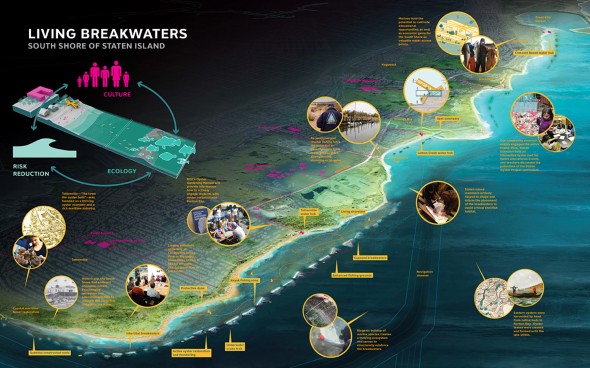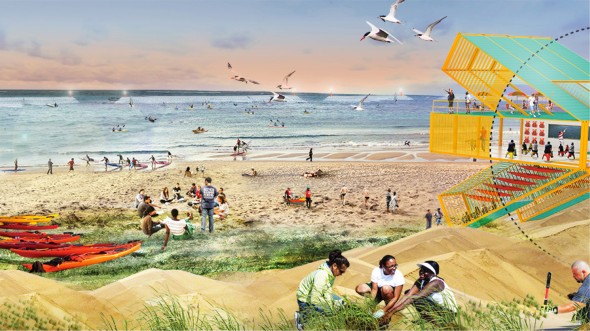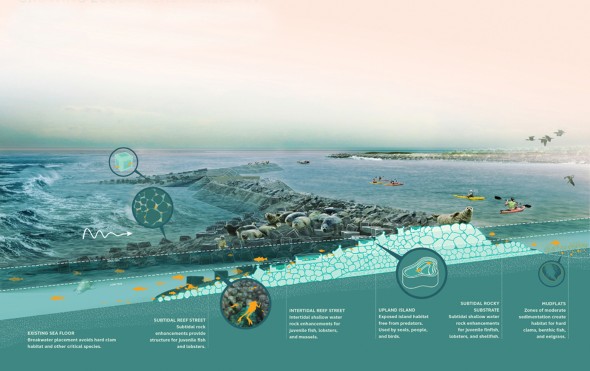

living breakwaters, a project submitted by scape / landscape architecture pllc based in new york has won the 2014 fuller challenge. the award offered by the the buckminster fuller institute (bfi) is considered “socially responsible design’s highest award”.
“living breakwaters is about dissipating and working with natural energy rather than fighting it. it is on the one hand an engineering and infrastructure-related intervention, but it also has a unique biological function as well. the project team understand that you cannot keep back coastal flooding in the context of climate change, but what you can do is ameliorate the force and impact of 100 and 500 year storm surges to diminish the damage through ecological interventions, while simultaneously catalyzing dialog to nurture future stewards of the built environment,” said bill browning of terrapin bright green, a 2014 senior advisor and jury member.

besides addressing storm surge issues, “oyster-tecture” will improve coastal resiliency and the restoration of livelihoods traditional to the community of tottenville in staten island. living breakwaters uses natural forces working with nature to create a natural barrier reef. criticism of “eco projects” has been commerce vs. nature, this project regenerates waterfront communities and social systems, while enhancing threatened ecosystems.

[ now hiring – as of 5 december 2014 ] images © scape
 architect norman foster
architect norman foster
The installation, a Miami Design District Dacra Project with in-kind support from The Buckminster Fuller Institute and Phillips, was on view during Design Miami/ in an open air space at 39th street and 1st Court, Dec 1 – 4, 2011. The exhibition set the stage for further evolution of these ideas and structures and included both the dome and the car; a series of films about Fuller and Foster; and a talk between renowned architect Norman Foster, his wife Elena Foster and W Magazine Editor-in-Chief, Stefano Tonchi, who spoke on Fuller’s influence on their lives and work as part of Design Miami’s Design Talks series.
 systems theorist, author, designer, inventor, and futurist buckminister fuller.
systems theorist, author, designer, inventor, and futurist buckminister fuller.
The exhibition, Architecting the Future: Buckminster Fuller & Norman Foster conceived and curated by DRDesign and Elizabeth Thompson, Executive Director of The Buckminster Fuller Institute was inspired by the photo of Bucky and the opportunity to ‘re-boot’ history by bringing the car and Foster to the exhibition — to, in the power of a single image, create a convergence of past & present to imagine a new future.
Inspired in part by their decade-long relationship – Foster has brought Fuller’s omni-directional approach, and world-around focus into the 21st century and beyond.The legacies of these two men entwined, set against a backdrop of radical innovation – still way ahead of our time.
The Fly’s Eye Dome will be permanently installed nearby in the Miami Design District.
[ About the Fly’s Eye Dome ]
“The Fly’s Eye domes are designed as components of a ‘livingry’ service. The basic hardware components will produce a beautiful, fully equipped, air-deliverable house that weighs and costs about as much as a good automobile. Not only will it be highly efficient in its use of energy and materials, it also will be capable of harvesting incoming light and wind energies.“ – R. Buckminster Fuller
[ About the Dymaxion Car ]
Patented in 1937, and conceived as an ‘omni-directional transport system’, Fuller’s Dymaxion car was intended to fly, jump-jet style, when suitable alloys and engines became available. Three cars were produced in his lifetime. [ design miami/ 2011 ]








